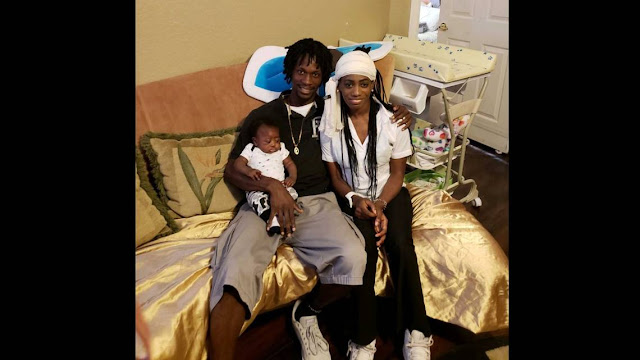Florida seized a disabled mom’s 4-day-old son:
‘I didn’t think this could happen in America’
Two days after Alysha Princess Cesaire gave birth to her son on Feb. 1, 2018, someone at Hollywood’s Memorial Regional Hospital phoned the state’s child abuse hotline to express concerns that Cesaire’s physical disability — which causes her to use a walker and have difficulty speaking — rendered her an unfit mother. Extended family members had cobbled together a plan to help the baby’s parents care for the child, Elijah Bastien, safely. But the Broward Sheriff’s Office, which investigates abuse allegations in the county, took custody of the boy at the hospital anyway, and asked a judge to make Elijah a dependent of the state.
In an internal email, the then-director of BSO’s Child Protective Investigative Section questioned why Cesaire’s family allowed her to have a child at all. “If there is such close supervision of this mother, how did she get [pregnant]?,” the former director, Kim Gorsuch, wrote, according to an email obtained by the Miami Herald. “And if they thought it was ok for her to be intimate, why didn’t they get her on some birth control???”
In a settlement to the civil rights lawsuit, Cesaire filed over Elijah’s removal from her care — a judge later ordered that he be returned — the state Department of Children & Families agreed last week to implement a raft of policy changes to align the department with federal civil rights laws that protect people with disabilities from discrimination. Among other provisions, the settlement requires DCF to “make reasonable efforts” to accommodate a person with disabilities “in order that the disabled parent can participate in recommended programs or services” necessary to keep a family intact and children safe. DCF’s Office of Civil Rights will be tasked, the settlement says, with “ensuring that, when necessary to avoid discrimination on the basis of disability, reasonable accommodations… and services requested are provided in an appropriate and timely manner in accordance with the [Americans with Disabilities Act].” DCF agreed to develop and implement a training curriculum to dispel stereotypes about people with disabilities and to help investigators and service providers strengthen the skills of parents with special needs. The settlement adds: DCF, its employees and contractors “will not base decisions about child safety actions on stereotypes or generalizations about parents with disabilities or on a parent’s disability, diagnosis, or intelligence measures alone.”
DCF, which outsources child abuse investigations to BSO under contract, also agreed to pay Cesaire’s lawyers $30,000 for litigating the claim. DCF did not acknowledge any wrongdoing, the settlement says. “I never did anything to anybody,” said Cesaire, 27. “And they wanted to take my child to a foster home.” Cesaire remembers lying on her hospital bed with Elijah next to her. “They took the baby away from me. I didn’t do anything wrong to the baby.” “My heart broke,” she added.
BSO declined to discuss the settlement, noting that BSO is still involved with the federal lawsuit. “Since this involves ongoing litigation, we will not be commenting at this time,” said agency spokeswoman Veda Coleman-Wright. A DCF spokeswoman issued a short statement about the case, noting that Elijah’s removal occurred four years ago, and that it is “not reflective of the way in which similarly situated cases would be handled today.” “The Department strives to ensure best practices are utilized in fulfilling Department responsibilities — including those delegated to our contractors/partners. As such, the Department has worked to increase its training for child welfare professionals and examined its policies and procedures regarding reasonable accommodations and auxiliary aids for parents with disabilities,” said Mallory McManus.
Cesaire was diagnosed in early childhood with “spinocerebellar ataxia,” a genetic neurological disorder. The condition makes it difficult for Cesaire to walk, coordinate the use of her hands and speak. In court pleadings, BSO also suggested Cesaire is cognitively delayed. Records obtained by the Miami Herald show someone at Memorial Regional — the documents aren’t clear who made the call — reported Cesaire to DCF when Elijah was born, suggesting Cesaire and the child’s father, Nickel Bastien, “are vulnerable adults who cannot independently meet their own basic needs, nor can they meet the needs of the baby.” A BSO investigator came to the hospital to look into the report. She interviewed Cesaire’s mother, who told her that the families of both parents had agreed upon a plan to ensure Elijah was safe, and never left alone with his parents. Specifically, Cesaire’s mother and aunt each were going to take time off from work, then the family would enroll him in day care. At night, Cesaire and her son would be overseen by family members. Bastien, the child’s father, denied he was incapable of being a parent. “He told [the investigator] that he is not disabled, he has a job, and he wants to be involved in caring for” Elijah, the suit stated. Nevertheless, the investigator told hospital staff not to allow the family to take Elijah home, and that BSO “will be removing” him, Cesaire’s lawsuit said.
Cesaire was diagnosed in early childhood with “spinocerebellar ataxia,” a genetic neurological disorder. The condition makes it difficult for Cesaire to walk, coordinate the use of her hands and speak. In court pleadings, BSO also suggested Cesaire is cognitively delayed. Records obtained by the Miami Herald show someone at Memorial Regional — the documents aren’t clear who made the call — reported Cesaire to DCF when Elijah was born, suggesting Cesaire and the child’s father, Nickel Bastien, “are vulnerable adults who cannot independently meet their own basic needs, nor can they meet the needs of the baby.” A BSO investigator came to the hospital to look into the report. She interviewed Cesaire’s mother, who told her that the families of both parents had agreed upon a plan to ensure Elijah was safe, and never left alone with his parents. Specifically, Cesaire’s mother and aunt each were going to take time off from work, then the family would enroll him in day care. At night, Cesaire and her son would be overseen by family members. Bastien, the child’s father, denied he was incapable of being a parent. “He told [the investigator] that he is not disabled, he has a job, and he wants to be involved in caring for” Elijah, the suit stated. Nevertheless, the investigator told hospital staff not to allow the family to take Elijah home, and that BSO “will be removing” him, Cesaire’s lawsuit said.
A court petition seeking custody of Elijah said “the parents are not meeting the child’s basic and essential needs for food, clothing and supervision and the child likely will be seriously harmed.” Elijah had not yet left the hospital, and Cesaire and her family had been given no opportunity to care for the newborn. Muller said she told investigators she and her daughter had “a lot of family here in America” and a “strong support team for the baby.” Muller told investigators that she has always cared for her daughter, and expects to “be caring for [her] for the rest of her life.” When her mother goes to work, Cesaire stays with a family friend, Nickel Bastien’s mom, the investigator was told. “The mother has a fervent desire to be a parent, and does not fully understand how her disability places the child at risk,” said a petition BSO filed to take custody of the newborn.
Muller said child welfare workers “dragged Alysha in front of a judge” as if she had done wrong. Broward Circuit Judge Alberto Ribas, who presided over BSO’s petition in child welfare court, denied the petition, writing there was no probable cause to remove Elijah from his parents. In an order dated Feb. 7, 2018, Ribas instructed BSO to execute a “safety plan” with the parents, and offer them services to help protect Elijah. “Family [is] to assist in caregiving for child,” Ribas wrote in his order. Under the Americans with Disabilities Act, a landmark civil rights law passed in 1990, BSO was required to “address the functional effects” of the parents’ special needs, and accommodate them where necessary to raise Elijah. After Ribas signed his order, BSO case workers continued to supervise the family for an additional three months, according to Muller and court records.
Caseworkers called constantly, Muller said. At all hours, they visited the Coral Springs home that Muller, Cesaire and Elijah share. “For three months they were knocking at my door, any day, any time,” Muller said. “They’d say, ‘We need to see Elijah now.” “It’s like me and my child did something wrong. What did we do wrong? They are knocking at my door early in the morning.” Matthew Dietz, one of three attorneys representing Cesaire — the other two are Stacie Schmerling and Howard Talenfeld — said BSO investigators and supervisors noted Cesaire’s physical challenges and made immediate and erroneous assumptions about her ability to be a parent. “The BSO child protective investigator took efforts to remark how Alysha was observed drooling, and that, based on her history, there was an implied threat to the safety of the baby,” Dietz said. “BSO deemed Alysha unfit to be a parent without any investigation of her abilities, or any services that could assist her.”
Said Dietz: “This settlement effectively changes the evaluation of parents to not focus on the disability as a disqualifying factor in the decision to shelter a child, but instead focus on what accommodations and community resources are available to assist a parent to be more successful in having a family.” Elijah, who just turned 4, is thriving, his grandmother said.
He loves to dart around on a scooter, which he got for Christmas. He plays with a tablet, and watches Mickey Mouse — though he prefers to be with family members rather than in a room watching television. He likes to kick a soccer ball around with his cousin. He’s a picky eater, Muller said. He likes “American food” like pasta, macaroni and cheese and potatoes — but not the stews that are a staple of his family’s Haitian culture. He prefers grits and strawberries to meat. He’ll put ketchup on almost anything, including just bread.
“He’s my little bundle of joy,” said Muller, who still tears up when discussing his first months. “It was really, really painful. I never thought that we could have that kind of treatment here in America. America says it cares for disabled persons. “But you have to expose yourself to the real world to see how it treats disabled people here in America.”
This story was originally published February 10, 2022 9:27 AM. CAROL MARBIN MILLER 305-206-2886 Carol Marbin Miller is the Herald’s deputy investigations editor. Carol grew up in North Miami Beach, and holds degrees from Florida State University and the Columbia University Graduate School of Journalism. She has written about children, elders and people with disabilities for 25 years. Stories written by Carol have influenced public policy and spurred legislative action, including the passage of laws that reformed the state’s involuntary commitment, child welfare and juvenile justice systems.
Read more at: https://www.miamiherald.com/news/health-care/article258155053.html#storylink=cpy
































